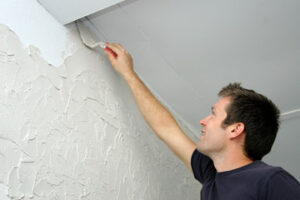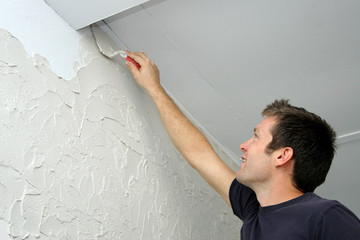Drywall is found throughout most homes and is susceptible to various sources of damage. From dents to cracks, it’s fairly easy for these minor issues to become larger problems that require a major drywall repair project. You can typically get the job done with some spackle, a putty knife, and sandpaper for nail holes and other small blemishes. But bigger repairs may require some extra help.
 Drywall is found throughout homes, from bedrooms and hallways to ceilings and basements. Over time, normal wear and tear can cause cracks, holes, and dents that aren’t necessarily structurally dangerous but are certainly unsightly. While a fresh coat of paint might temporarily hide these issues, a professional Drywall Repair Las Vegas must fix the underlying problems and ensure your walls and ceilings are safe.
Drywall is found throughout homes, from bedrooms and hallways to ceilings and basements. Over time, normal wear and tear can cause cracks, holes, and dents that aren’t necessarily structurally dangerous but are certainly unsightly. While a fresh coat of paint might temporarily hide these issues, a professional Drywall Repair Las Vegas must fix the underlying problems and ensure your walls and ceilings are safe.
While plenty of drywall patch kits are on the market, they often require a long drying time and sanding that can be difficult for homeowners to accomplish. In contrast, a product like the Eclipse(r) Rapid Wall Repair Patch can make the job go faster and easier while also delivering that super smooth, finished look that even some perfectionists might be after.
Before you begin drywall repairs, it’s important to lay down drop cloths or tarps to catch all the pieces of drywall that will be removed and to protect surrounding surfaces from dust and debris. It’s also a good idea to put on some sturdy work gloves and safety goggles as working with drywall creates a lot of fine dust that can be irritating to the eyes and nose.
When two sheets of drywall meet at a corner, they’re protected by an L-shaped metal strip called a corner bead that is nailed to the corners and concealed with several layers of joint compound. Despite its toughness, this bead is not indestructible and can get dented from run-ins with the vacuum cleaner or from kids flinging toys into the corner. When this happens, removing the affected section of drywall is simple enough, but it’s important to carefully mark out the area before using a power saw so that you don’t accidentally cut into the wood framing beneath the drywall.
Nail and screw pops are another common issue caused by lumber shrinkage that can leave exposed fasteners behind. If you can see the nail head, gently pound a pry bar underneath the surface of the drywall until it pops up and then use a hammer to nudge the nail out.
Patching the Holes
Drywall repair is a skill that every home renovator should learn. It’s not difficult, and it’s one of the most satisfying home improvement tasks for anyone to do. Whether you’re a serial renter or a bona fide homeowner, drywall patching can save your bacon when something goes wrong in your home. It’s also useful for those wishing to spruce up their homes on a budget.
Most holes in drywall are caused by either accident or intent, such as accidentally swinging a doorknob too hard or using the wall to hang paintings or mirrors. Small dents and dings that have not significantly weakened the drywall are easily repaired with a spackle or drywall compound.
If the hole is large, however, you may need to cut a new piece of drywall to replace it and add extra support. This type of drywall patch is typically supported by strips of wood installed inside the gap on both sides. This prevents the patch from collapsing into the hole.
You can purchase a pre-mixed drywall patch kit for this type of repair, which is easier and faster than mixing your own compound. The patch itself is essentially a sheet of drywall with an adhesive backing that sticks to the wall. To prepare it, you need to clear away any loose or chipped edges and ensure that the surface is smooth. You should also tie a string around the center of the patch and use it to pull it gently into place against the wall.
To make a custom drywall patch, measure the dimensions of the damaged area and then cut a piece of drywall to fit it. If the hole is near a joint, you should lay down some 1/8-inch-thick bed of drywall compound and press paper tape into it. Next, spread a second coat of compound, working it at least 6 inches beyond the edge of the first coat to create a taped seam.
After the drywall patch has dried, you should lightly sand it with 100-grit sandpaper to remove any ridges and blend it with the surrounding wall. At this point, you can re-paint the patched area to match the rest of the wall.
Applying Joint Compound
Drywall compound is a gypsum-based mixture that helps give walls a finished look by securing drywall tape, sealing seams and covering nail and screw holes. It is available in setting-type and premixed varieties. Choose the kind that best matches the conditions of your project.
When applying the compound to a surface, always apply a thin coat. This allows the compound to dry and sand more easily without leaving an uneven or patchy surface. It is also a good idea to use a sanding sponge instead of a regular sandpaper to ensure that the area is smooth and ready for painting.
If you notice a hairline crack that is not going to get any larger, sand the area with a sanding sponge and vacuum away any loose dust before applying a second thin coat of joint compound. This will discourage the crack from reappearing and help prevent it from becoming worse over time.
It is important to keep in mind that both sanding and using joint compound produce a lot of dust. You should wear a mask or respirator to avoid breathing the dust. It contains super-fine gypsum and silica particulates that can irritate your respiratory system.
Unlike spackle, drywall joint compound is designed to cover the seams that lay between two pieces of drywall. To make the process easier, first cut the paper tape into lengths that are equal to the height of the seam you’re working on.
Next, use a trowel to apply a thin coat of drywall joint compound over the exposed seams. Then press the tape into place and apply another coat of compound over the top of it. Once the second coat of compound has dried, sand it with a sanding sponge to remove any ridges and smooth the surface of the wall.
Once the sanding and compound have been completed, you’ll need to prime and paint the repaired area. It’s a good idea to test the color of the paint on an inconspicuous part of the wall to ensure that it matches the rest of the room.
Overall, the entire drywall repair process should not take more than four days if you have experience with DIY projects. However, if the damage is severe and requires new drywall to be installed, you may want to consider hiring a professional.
Finishing the Job
The interior walls and ceilings of most homes are covered with gypsum wallboard, more commonly known as drywall or Sheetrock. While it is fairly durable, drywall can only take so much abuse before holes, cracks, and dents start to appear. If left unattended, even these small imperfections can make your home look sloppy and can lead to costly repairs.
For the do-it-yourselfer, repairing drywall damage is actually quite an easy project. For smaller holes, a patch kit and some drywall compound or spackles are all that is required to conceal the problem. However, bigger projects can be tricky. Nail pops, in particular, can be a challenge to repair for many people. This occurs when nails holding the drywall begin to pop through the plaster and paint that conceals them. This type of drywall repair requires skill and experience with plaster texturing techniques. If you are not accustomed to working with plaster, it is best to leave nail pops to the professionals.
Other issues that require drywall repair include dents and long, tiny cracks. These cracks are caused by the expansion and contraction of the wooden studs that the drywall is attached to. This is normal and happens in every home and commercial building, but can cause problems with the drywall if not addressed quickly enough. It is important to note that cracks in drywall can also indicate a serious structural issue and it is recommended that these be checked by a professional.
Once the drywall has been repaired, it is necessary to let it dry. This process can take up to three hours and it is important that you keep the area as well ventilated as possible. Once the drywall is completely dry, a light sanding with a sanding sponge can help to smooth out any uneven areas and to give your drywall a nice finish.
When it comes to drywall repair, the more extensive the job, the longer it will take to complete. It is also important to remember that you must wait for the drywall to fully cure before painting it. This can be a few days or even a week, depending on the environmental conditions and the size of the damage.

